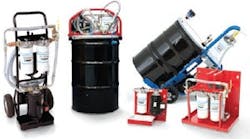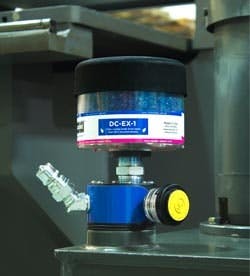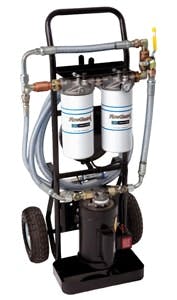The methods by which lubricants are stored, transferred and applied to machines play a large role in the success of a lubrication program. If you start out with contaminated oil, you will never achieve cleanliness targets for most machines. Implementing a world-class lubrication program is a sizable undertaking, but storage and handling is one area where you can affect the quality of lubrication for the whole plant in one stroke.
With few exceptions, new lubricants are unsuitably dirty for most applications. It is therefore imperative that new oil is properly filtered before it is installed for use. A new drum of lubricating oil will typically have a particle count of approximately 19/16/13 or higher. That means that every cubic centimeter of oil in the drum contains between 2,500 and 5,000 particles that are at least 4 microns in diameter, or about one billion particles for the whole drum. So if particle contamination is the number one cause of machine wear–and it is–then there is a compelling case to be made for filtering “new” oil.
Step 1: Get it clean
The first step in new oil cleanliness is to filter it to an acceptable level. How the new oil is filtered depends on the method of delivery. If it comes in drums, each drum can be filtered using portable, compact filtration units (Figure 1). If the volume is sufficiently large, the oil can be filtered as it is transferred.
Another popular method, which covers a wider range of storage and handling issues, is the use of a comprehensive lubricant management system (Figure 2). These systems can be configured with a wide range of options including separate pumps and filters for each lubricant, high-quality desiccant breathers to prevent subsequent contamination to the fluid, fittings and spigots that minimize contamination, and even flowmeters to measure and track the amount of oil dispensed.
Systems like these allow us to easily clean new oil, keep it clean, prevent cross-contamination, and track lubricant consumption by product type without having to engineer the process from scratch.
Step 2: Keep it clean
Keeping oil clean is not difficult if you use the right tools. It certainly helps to have an enclosed storage area with climate control, but these items are not essential for keeping oil clean. Common sense measures like good house-keeping, wiping fittings, and using dust covers can go a long way toward keeping dirt out of stored lubricants, but the best way to prevent dirt and moisture from entering a tank or drum is to use a high-quality desiccant breather (Figure 3). Remember, when you remove five gallons of oil from a drum, you pull in five gallons of air. If that air is not clean and dry, neither will the oil be.
Step 3: Transfer it clean
It really doesn’t matter how well you filter new oil if you dispense it into a dirty container. Several acceptable options exist for delivering oil to machinery, and some are better than others. For large and moderate sized systems, the best method is usually to pump oil directly into the sump from a drum or tote using a filter cart (Figure 4). Portable filter carts are one of the most versatile and effective tools available for lubricant transfers and decontamination. When using filter carts, make sure you use the right fittings on the equipment sumps to make the fluid transfer or decontamination efficient and effective.
Additionally, consider using units that are dedicated to specific oil types, in order to prevent cross-contamination of lubricants and avoid the labor intensive process of flushing carts to switch products. Some manufacturers allow you to color-code your filtration unit to help identify which cart should be used with a particular lubricant. As a side benefit, most users find that performing an oil change with a filter cart only takes about half the time as performing the job with conventional methods.
Finally, for those applications with small sumps, oil transfer containers are acceptable as long as they meet certain criteria. A good oil transfer container should be plastic, sealable, color-coded or marked for product type, and it must be cleaned on a regular basis. The container also should have an opening large enough to allow the inside of the container to be effectively cleaned. When using top-off containers, remember to avoid funnels whenever possible. Many of the new containers utilize hand-pumps that eliminate the need for funnels.
World-class lubrication cannot happen in the absence of good lubricant handling practices. Any good storage and handling policy or system has several common elements: good filtration, high-quality breathers, filter carts, and a highly conspicuous tagging or color coding system to avoid cross-contamination of products. When these four items are addressed, the majority of the work is done. The rest is just fine tuning.





